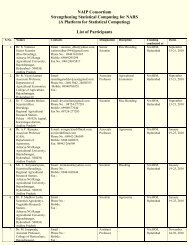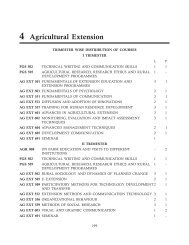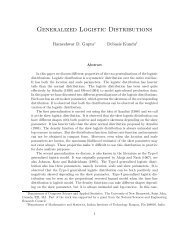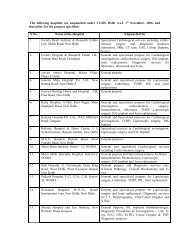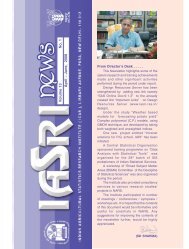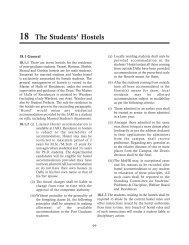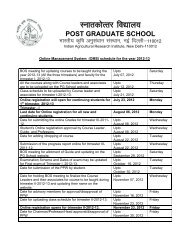Achievements in Applied Research in Sample Survey at IASRI
Achievements in Applied Research in Sample Survey at IASRI
Achievements in Applied Research in Sample Survey at IASRI
Create successful ePaper yourself
Turn your PDF publications into a flip-book with our unique Google optimized e-Paper software.
<strong>Achievements</strong> <strong>in</strong> <strong>Applied</strong> <strong>Research</strong> <strong>in</strong> <strong>Sample</strong> <strong>Survey</strong> <strong>at</strong> <strong>IASRI</strong><br />
Tauqueer Ahmad, U.C. Sud, Prachi Misra Sahoo,<br />
Hukum Chandra and Vijay B<strong>in</strong>dal<br />
1. Introduction<br />
The Indian Agricultural St<strong>at</strong>istics <strong>Research</strong> Institute is a pioneer<strong>in</strong>g Institute <strong>in</strong> the field of research <strong>in</strong><br />
Agricultural St<strong>at</strong>istics <strong>in</strong> India which made a modest beg<strong>in</strong>n<strong>in</strong>g <strong>in</strong> 1930 as St<strong>at</strong>istical Section of the<br />
Indian (then Imperial) Council of Agricultural <strong>Research</strong>. As per the mand<strong>at</strong>es of the Institute to promote<br />
and conduct research <strong>in</strong> Agricultural St<strong>at</strong>istics, the Institute has contributed significantly over the years <strong>in</strong><br />
research <strong>in</strong> the field of sample surveys, design of experiments, st<strong>at</strong>istical genetics, bio-st<strong>at</strong>istics, forecast<strong>in</strong>g<br />
techniques, st<strong>at</strong>istical economics and computer applic<strong>at</strong>ions. The development of suitable sample survey<br />
methodologies for estim<strong>at</strong>ion of various parameters perta<strong>in</strong><strong>in</strong>g to crops, livestock, fisheries production<br />
and allied fields have always been one of the most important activities of the Institute from the very<br />
beg<strong>in</strong>n<strong>in</strong>g. The Institute was <strong>in</strong>strumental <strong>in</strong> the development of sample survey methodology for estim<strong>at</strong>ion<br />
of crop production through crop cutt<strong>in</strong>g approach which formed a sound objective method of estim<strong>at</strong><strong>in</strong>g<br />
crop production <strong>in</strong> the country. The sample survey methodologies for estim<strong>at</strong>ion of livestock numbers,<br />
products and <strong>at</strong>tendant practices, for estim<strong>at</strong>ion of extent of cultiv<strong>at</strong>ion and production of fruits and<br />
vegetables, for estim<strong>at</strong>ion of fish c<strong>at</strong>ch both from mar<strong>in</strong>e and <strong>in</strong>land resources, for estim<strong>at</strong>ion of cost of<br />
production of crops as well as livestock products and for evalu<strong>at</strong>ion studies such as assessment of<br />
development programmes like IADP, HYVP, dairy improvement programmes etc. are other important<br />
contributions of the Institute. Most of the methodologies evolved are be<strong>in</strong>g adopted by the concerned<br />
departments <strong>in</strong> various st<strong>at</strong>es of the country and this work is be<strong>in</strong>g coord<strong>in</strong><strong>at</strong>ed by the Director<strong>at</strong>e of<br />
Economics and St<strong>at</strong>istics and other concerned w<strong>in</strong>gs of the M<strong>in</strong>istry of Agriculture, Government of India.<br />
Some of these methodologies are be<strong>in</strong>g <strong>in</strong>tern<strong>at</strong>ionally used.<br />
In this article, the research highlights <strong>in</strong> sample survey <strong>at</strong> the Institute <strong>in</strong> different areas of applied<br />
research have been presented.<br />
2. Sampl<strong>in</strong>g Methodologies Developed - At a Glance<br />
One of the most strik<strong>in</strong>g fe<strong>at</strong>ures of recent development <strong>in</strong> st<strong>at</strong>istics is the rapid growth of <strong>in</strong>terest <strong>in</strong><br />
development of sampl<strong>in</strong>g methodologies and their applic<strong>at</strong>ions as well. The sampl<strong>in</strong>g approach be<strong>in</strong>g a<br />
most cost prohibited way of obta<strong>in</strong><strong>in</strong>g an estim<strong>at</strong>e of a character of a popul<strong>at</strong>ion has compelled the survey<br />
st<strong>at</strong>isticians to probe <strong>in</strong>to problems of basic research. <strong>Survey</strong> sampl<strong>in</strong>g has considerably helped the<br />
concerned organiz<strong>at</strong>ions <strong>in</strong> provid<strong>in</strong>g estim<strong>at</strong>ion of important popul<strong>at</strong>ion parameters for scientific plann<strong>in</strong>g<br />
<strong>in</strong> various developmental programmes. The Division of <strong>Sample</strong> <strong>Survey</strong> of the Institute undertook research<br />
<strong>in</strong> sample survey techniques and their applic<strong>at</strong>ion <strong>in</strong> agriculture, animal husbandry, fisheries, forestry and<br />
allied fields. By now, several methodological <strong>in</strong>vestig<strong>at</strong>ions have been carried out by the Division for<br />
evolv<strong>in</strong>g suitable sampl<strong>in</strong>g methodologies. Some of the methodologies have been adopted by St<strong>at</strong>e<br />
Departments and other rel<strong>at</strong>ed agencies and some are <strong>in</strong> the process of implement<strong>at</strong>ion. The broad c<strong>at</strong>egories<br />
under which these methodologies can be classified are:
<strong>IASRI</strong> – An era of excellence<br />
(i)<br />
(ii)<br />
Crops<br />
Horticulture and Plant<strong>at</strong>ion crops<br />
(iii) Livestock<br />
(iv)<br />
(v)<br />
Fisheries<br />
Evalu<strong>at</strong>ion studies, Demographic studies, Socio-economic studies and all such studies which do<br />
not fall under above st<strong>at</strong>ed four c<strong>at</strong>egories.<br />
2.1 <strong>Survey</strong>s on crops<br />
One of the essential fe<strong>at</strong>ures for viability of any survey methodology is th<strong>at</strong> it must be <strong>in</strong> conformity<br />
with the available <strong>in</strong>frastructure. For estim<strong>at</strong>ion of production of crops, one could concentr<strong>at</strong>e on obta<strong>in</strong><strong>in</strong>g<br />
<strong>in</strong>form<strong>at</strong>ion on production of crops from the ultim<strong>at</strong>e units. However, <strong>in</strong> the context of our country,<br />
estim<strong>at</strong>ion of area and yield is important which ultim<strong>at</strong>ely gives the production of crops.<br />
Before 1919, method of determ<strong>in</strong><strong>in</strong>g crop yield was be<strong>in</strong>g done by traditional method. This method<br />
however, was subjective and unreliable. In 1919, objective method of crop cutt<strong>in</strong>g experiments by random<br />
selection of villages, fields and plots was recommended by Board of Agriculture. Initial <strong>at</strong>tempt <strong>in</strong> practice<br />
goes to Hubback (1923-25) for carry<strong>in</strong>g out surveys for estim<strong>at</strong>ion of yield of paddy <strong>in</strong> Bihar and Orissa.<br />
Hubback’s idea of random sampl<strong>in</strong>g was pursued further for estim<strong>at</strong>ion of area and yield of jute crops. It<br />
may be mentioned th<strong>at</strong> before <strong>in</strong>dependence, cash crops were considered more important as a source of<br />
revenue.<br />
Before 1943-44, the official procedure of annawari estim<strong>at</strong>ion was defective and unreliable. This<br />
resulted <strong>in</strong> grave lacuna <strong>in</strong> the official estim<strong>at</strong>es of yield of food gra<strong>in</strong>s. A serious food crisis occurred <strong>in</strong><br />
the country <strong>in</strong> which Bengal fam<strong>in</strong>e was worst. This crisis could have been averted if reliable estim<strong>at</strong>es of<br />
yield of food crops could be available.<br />
Estim<strong>at</strong>ion of production of food crops was taken up seriously by Government of India. The Indian<br />
Council of Agricultural <strong>Research</strong> (ICAR) <strong>in</strong>iti<strong>at</strong>ed pilot studies for develop<strong>in</strong>g methodologies for estim<strong>at</strong>ion<br />
of area and production of important food crops under the leadership of Sukh<strong>at</strong>me (1943-44).<br />
The significant research <strong>in</strong> crop surveys <strong>in</strong> <strong>Sample</strong> <strong>Survey</strong> <strong>at</strong> the Institute are as under:<br />
The method of crop cutt<strong>in</strong>g experiments developed <strong>in</strong> mid-forties for estim<strong>at</strong>ion of yield of a crop was<br />
standardized for different field crops which is widely adopted for estim<strong>at</strong>ion of production of pr<strong>in</strong>cipal<br />
crops <strong>in</strong> India and other develop<strong>in</strong>g countries. The standardized method of crop cutt<strong>in</strong>g experiments is a<br />
sound objective method of estim<strong>at</strong>ion of crop production.<br />
In order to estim<strong>at</strong>e the cost of cultiv<strong>at</strong>ion of important food and cash crops, sampl<strong>in</strong>g techniques<br />
were developed. The developed methodology was adopted by the M<strong>in</strong>istry of Agriculture <strong>in</strong> the<br />
comprehensive survey on cost of cultiv<strong>at</strong>ion of pr<strong>in</strong>cipal crops which forms the basis of fix<strong>in</strong>g remuner<strong>at</strong>ive<br />
prices of agricultural commodities.<br />
A suitable sampl<strong>in</strong>g and measurement techniques were evolved for estim<strong>at</strong>ion of <strong>in</strong>cidence of pests<br />
and diseases and assessment of consequent loss <strong>in</strong> yield of paddy, whe<strong>at</strong> and maize crops.<br />
102
<strong>Achievements</strong> <strong>in</strong> <strong>Applied</strong> <strong>Research</strong> <strong>in</strong> <strong>Sample</strong> <strong>Survey</strong> <strong>at</strong> <strong>IASRI</strong><br />
In view of the importance given to the production of fodder <strong>in</strong> the Intensive C<strong>at</strong>tle Development<br />
Programme, pilot surveys were undertaken for evolv<strong>in</strong>g sampl<strong>in</strong>g methodology for estim<strong>at</strong>ion of area,<br />
yield and production of pr<strong>in</strong>cipal cultiv<strong>at</strong>ed fodder crops.<br />
Based on two surveys carried out, a suitable sampl<strong>in</strong>g methodology for estim<strong>at</strong>ion of area of graz<strong>in</strong>g<br />
land and average yield per unit of graz<strong>in</strong>g area <strong>in</strong> different seasons was evolved and chemical composition<br />
and botanical classific<strong>at</strong>ion of grasses <strong>in</strong> each season were studied.<br />
With the emphasis on white revolution, studies on cost of production of fodder crops assumed special<br />
importance, as cultiv<strong>at</strong>ed fodders are the major <strong>in</strong>puts <strong>in</strong> dairy farm<strong>in</strong>g. The methodology available for<br />
estim<strong>at</strong><strong>in</strong>g the cost of cultiv<strong>at</strong>ion of cereal and cash crops did not seem to fit <strong>in</strong>to studies on cost of<br />
production of fodder crops. With this <strong>in</strong> view, a pilot study for develop<strong>in</strong>g a suitable methodology for<br />
estim<strong>at</strong>ion of cost of cultiv<strong>at</strong>ion of fodder crops was undertaken <strong>in</strong> Jalandhar tehsil of Punjab St<strong>at</strong>e.<br />
A study was conducted to estim<strong>at</strong>e the cost of cultiv<strong>at</strong>ion as well as cost of production of pot<strong>at</strong>o, to<br />
estim<strong>at</strong>e the area and yield r<strong>at</strong>es of different varieties of pot<strong>at</strong>o and to study the extent of adoption of<br />
improved agronomic practices under cultiv<strong>at</strong>or’s conditions.<br />
In view of the difficulties to capture all the pick<strong>in</strong>gs of cotton dur<strong>in</strong>g its long period of harvest<strong>in</strong>g, a<br />
study was undertaken to develop methodology for estim<strong>at</strong>ion of yield of cotton on the basis of d<strong>at</strong>a of<br />
past few pick<strong>in</strong>gs. The results showed th<strong>at</strong> it was possible to estim<strong>at</strong>e the yield of cotton with good<br />
precision by adopt<strong>in</strong>g double sampl<strong>in</strong>g approach. In order to forecast the yield of cotton based on d<strong>at</strong>a of<br />
first one or two pick<strong>in</strong>gs, number of bolls, number of plants and plant height, multiple l<strong>in</strong>ear regression<br />
approach was tried successfully.<br />
In view of unavailability of standard methodology for estim<strong>at</strong>ion of foodgra<strong>in</strong> losses, a survey was<br />
conducted <strong>in</strong> order to develop a suitable st<strong>at</strong>istical methodology for estim<strong>at</strong>ion of post-harvest foodgra<strong>in</strong><br />
losses specially, whe<strong>at</strong>.<br />
A sampl<strong>in</strong>g methodology was developed to estim<strong>at</strong>e area and production of cultiv<strong>at</strong>ed fodder crops<br />
other than Jowar and Berseem and to review regular production on the l<strong>in</strong>es of food-gra<strong>in</strong>s.<br />
With the advent of remote sens<strong>in</strong>g technology dur<strong>in</strong>g 1970s, it’s gre<strong>at</strong> potential <strong>in</strong> the field of agriculture<br />
opened new vistas of improv<strong>in</strong>g the agricultural st<strong>at</strong>istics system all over the world. An <strong>at</strong>tempt was made<br />
to develop a suitable methodology for estim<strong>at</strong>ion of crop acreage, crop yield and crop yield forecast<strong>in</strong>g<br />
us<strong>in</strong>g remote sens<strong>in</strong>g techniques.<br />
The methodology developed under the previous study for crop yield estim<strong>at</strong>ion us<strong>in</strong>g remote sens<strong>in</strong>g<br />
techniques was tested and an improved estim<strong>at</strong>or of crop yield was obta<strong>in</strong>ed us<strong>in</strong>g post str<strong>at</strong>ific<strong>at</strong>ion<br />
based on s<strong>at</strong>ellite d<strong>at</strong>a <strong>in</strong> the form of veget<strong>at</strong>ion <strong>in</strong>dices.<br />
A study was conducted to explore various possibilities of obta<strong>in</strong><strong>in</strong>g reliable land utiliz<strong>at</strong>ion st<strong>at</strong>istics<br />
with m<strong>in</strong>imum time lag <strong>at</strong> any smaller geographical level i.e. panchay<strong>at</strong>s/blocks/tehsils based on sample<br />
survey us<strong>in</strong>g sp<strong>at</strong>ial sampl<strong>in</strong>g and remote sens<strong>in</strong>g techniques. Under this study, suitable models were<br />
developed for <strong>in</strong>tegr<strong>at</strong>ion of land use st<strong>at</strong>istics obta<strong>in</strong>ed through different sources i.e. the complete<br />
enumer<strong>at</strong>ion, sp<strong>at</strong>ial survey and remote sens<strong>in</strong>g.<br />
A methodology was developed to estim<strong>at</strong>e the various post-harvest food gra<strong>in</strong> losses due to oper<strong>at</strong>ional<br />
and casual factors and also due to periodic/seasonal fluctu<strong>at</strong>ions.<br />
103
<strong>IASRI</strong> – An era of excellence<br />
In view of the importance of fertilizers for <strong>in</strong>creas<strong>in</strong>g productivity <strong>in</strong> agriculture, a sampl<strong>in</strong>g procedure<br />
for selection of represent<strong>at</strong>ive samples of fertilizer from ship was developed.<br />
A methodology based on Crop Cutt<strong>in</strong>g Experiments (CCE) d<strong>at</strong>a as well as farmer appraisal d<strong>at</strong>a of<br />
crop produce was developed to estim<strong>at</strong>e precise yield r<strong>at</strong>es of different crops <strong>at</strong> Community Development<br />
Block (CDB) level.<br />
A methodology was developed to estim<strong>at</strong>e the cost of production of coconut. The cost of production<br />
of coconut was obta<strong>in</strong>ed by tak<strong>in</strong>g <strong>in</strong>to account the establishment cost of orchard as well as the annual<br />
ma<strong>in</strong>tenance cost.<br />
The Small Area Crop Estim<strong>at</strong>ion Approach (SACEA) developed by the <strong>IASRI</strong> for assessment of yield<br />
r<strong>at</strong>es of different crops <strong>at</strong> the Gram Panchay<strong>at</strong> level was tested for large scale adoption <strong>in</strong> one district each<br />
of the St<strong>at</strong>e of Uttar Pradesh, Punjab, Rajasthan, Andhra Pradesh and Karn<strong>at</strong>aka. The standard errors of<br />
the estim<strong>at</strong>es were <strong>in</strong> the acceptable range. The report of the study was submitted to the Department of<br />
Agriculture & Co-oper<strong>at</strong>ion, M<strong>in</strong>istry of Agriculture.<br />
A study to estim<strong>at</strong>e the crop yield <strong>at</strong> small area level for pr<strong>in</strong>cipal crops namely, whe<strong>at</strong> and paddy<br />
us<strong>in</strong>g small area estim<strong>at</strong>ion techniques was carried out to exam<strong>in</strong>e its applicability for gett<strong>in</strong>g reliable<br />
estim<strong>at</strong>es of yield <strong>at</strong> lower levels such as block/tehsil which are very much needed for the purpose of<br />
micro level plann<strong>in</strong>g.<br />
An appropri<strong>at</strong>e sampl<strong>in</strong>g methodology for estim<strong>at</strong>ion of area under paddy <strong>in</strong> Meghalaya st<strong>at</strong>e was<br />
developed us<strong>in</strong>g remote sens<strong>in</strong>g, GIS and ground survey. The developed methodology has been<br />
implemented <strong>in</strong> Meghalaya and an <strong>at</strong>tempt is be<strong>in</strong>g made to adopt the methodology for estim<strong>at</strong>ion of area<br />
under paddy <strong>in</strong> other st<strong>at</strong>es of North-East region. The report of the study was submitted to Space Applic<strong>at</strong>ion<br />
Centre, Ahmedabad.<br />
A study is be<strong>in</strong>g conducted <strong>in</strong> two St<strong>at</strong>es namely, Maharashtra and Andhra Pradesh <strong>in</strong> order to <strong>in</strong>vestig<strong>at</strong>e<br />
the causes of vari<strong>at</strong>ion between official and trade estim<strong>at</strong>es of cotton production and to suggest ways and<br />
means for improv<strong>in</strong>g the reliability of estim<strong>at</strong>es of Cotton production from the two sources. The study so<br />
far has revealed th<strong>at</strong> official estim<strong>at</strong>e is based on scientific methodology. The methodology is objective,<br />
scientific and verifiable and sampl<strong>in</strong>g design is proper but various problems have been observed <strong>in</strong> actual<br />
implement<strong>at</strong>ion of the Crop Cutt<strong>in</strong>g Experiment (CCE) scheme for Cotton. There is no scientific<br />
methodology for obta<strong>in</strong><strong>in</strong>g trade estim<strong>at</strong>es. The <strong>in</strong>terim report of the study was submitted to the DES,<br />
Department of Agriculture & Co-oper<strong>at</strong>ion, M<strong>in</strong>istry of Agriculture.<br />
In view of the successful adoption of methodology for estim<strong>at</strong>ion of area under paddy <strong>in</strong> Meghalaya<br />
st<strong>at</strong>e, a study is be<strong>in</strong>g conducted <strong>in</strong> North-East hilly region <strong>in</strong> order to develop an <strong>in</strong>tegr<strong>at</strong>ed methodology<br />
for area estim<strong>at</strong>ion of major crops i.e. paddy, maize, pot<strong>at</strong>o, g<strong>in</strong>ger, p<strong>in</strong>eapple, cashewnut and vegetable<br />
as a group us<strong>in</strong>g remote sens<strong>in</strong>g, GIS and ground survey.<br />
2.2 <strong>Survey</strong>s on horticulture and plant<strong>at</strong>ion crops<br />
Horticulture and plant<strong>at</strong>ion crops contribute <strong>in</strong> various ways towards the prosperity of a n<strong>at</strong>ion.<br />
Cultiv<strong>at</strong>ion of fruits and vegetables, if taken as organized <strong>in</strong>dustry, has scope for employment and upliftment<br />
of rural popul<strong>at</strong>ion. Some of the plant<strong>at</strong>ion crops like coconut, arecanut, cashewnut etc. and spices like<br />
pepper etc. are important from <strong>in</strong>ternal consumption angle and export po<strong>in</strong>t of view. Lac is another<br />
104
<strong>Achievements</strong> <strong>in</strong> <strong>Applied</strong> <strong>Research</strong> <strong>in</strong> <strong>Sample</strong> <strong>Survey</strong> <strong>at</strong> <strong>IASRI</strong><br />
commodity of similar value. Lac and cashew are grown <strong>in</strong> economically backward rural areas such as<br />
hilly and tribal areas. The st<strong>at</strong>us of st<strong>at</strong>istics regard<strong>in</strong>g these crops is not very s<strong>at</strong>isfactory. The sampl<strong>in</strong>g<br />
technique developed for estim<strong>at</strong>ion of area and yield of various field crops can not be directly applied to<br />
horticultural and plant<strong>at</strong>ion crops due to <strong>in</strong>herent differences <strong>in</strong> various aspects like sow<strong>in</strong>g, growth<br />
period, cultiv<strong>at</strong>ion practices, harvest<strong>in</strong>g etc. Accord<strong>in</strong>gly, <strong>IASRI</strong> bore the brunt of develop<strong>in</strong>g methodology<br />
for area and yield st<strong>at</strong>istics of these crops. The significant surveys by the Division of <strong>Sample</strong> <strong>Survey</strong> of<br />
the Institute are as under:<br />
A suitable methodology for estim<strong>at</strong>ion of area and production of important plant<strong>at</strong>ion crops like<br />
arecanut, coconut and cashewnut was developed and is be<strong>in</strong>g used <strong>in</strong> major grow<strong>in</strong>g areas.<br />
A survey was conducted for estim<strong>at</strong>ion of yield of lime and to study the cultiv<strong>at</strong>ion practices of lime<br />
<strong>in</strong> Nellore district of Andhra Pradesh.<br />
A methodology was developed for simultaneous estim<strong>at</strong>ion of area and production of fruits and<br />
vegetables and to study their market<strong>in</strong>g practices.<br />
For estim<strong>at</strong>ion of cost of production of major fruits and perennial crops, sampl<strong>in</strong>g techniques were<br />
developed.<br />
In order to develop a methodology for estim<strong>at</strong>ion of production of lac and extent of adoption of<br />
improved practices for its cultiv<strong>at</strong>ion and remuner<strong>at</strong>ion received by the tribals, a survey was conducted <strong>in</strong><br />
Bihar. The yield as well as production of lac were found to be gre<strong>at</strong>ly <strong>in</strong>fluenced by the price received by<br />
the tribals and, therefore, for ma<strong>in</strong>ta<strong>in</strong><strong>in</strong>g production <strong>at</strong> reasonable level, adequ<strong>at</strong>e market<strong>in</strong>g facilities<br />
and support price would have to be ensured.<br />
A pilot sample survey was conducted <strong>in</strong> Valsad district of Gujar<strong>at</strong> st<strong>at</strong>e for determ<strong>in</strong><strong>in</strong>g the cost of<br />
production of Chikoo and for study<strong>in</strong>g its market<strong>in</strong>g practices.<br />
An appropri<strong>at</strong>e methodology for estim<strong>at</strong>ion of area and production of major fruits was standardized<br />
based on a series of pilot sample surveys conducted for the purpose <strong>in</strong> important fruit grow<strong>in</strong>g regions <strong>in</strong><br />
the country.<br />
A series of pilot sample surveys were conducted for develop<strong>in</strong>g sampl<strong>in</strong>g methodology for estim<strong>at</strong>ion<br />
of area and production of different vegetables <strong>in</strong> important areas like Delhi, Bangalore, Pune and Nasik.<br />
A suitable methodology for the purpose was standardized. <strong>Survey</strong>s on market<strong>in</strong>g of vegetables and their<br />
price spread were conducted <strong>in</strong> Delhi to <strong>in</strong>vestig<strong>at</strong>e the share of growers vis-à-vis various <strong>in</strong>termediaries<br />
like wholesalers, retailers etc. on the price paid by the consumers. It was found th<strong>at</strong> the share of the<br />
<strong>in</strong>termediaries formed a substantial component of the f<strong>in</strong>al price of vegetable.<br />
<strong>Survey</strong>s were undertaken on cost of cultiv<strong>at</strong>ion of crops like orange <strong>in</strong> Maharashtra, banana and<br />
mango <strong>in</strong> Gujar<strong>at</strong>, vegetables <strong>in</strong> Delhi and Gujar<strong>at</strong> and oilseeds and pulses <strong>in</strong> important grow<strong>in</strong>g regions<br />
of the country. These surveys provided valuable <strong>in</strong>form<strong>at</strong>ion on the various cost components of these<br />
commodities as well as return to the cultiv<strong>at</strong>ors with known degree of reliability.<br />
A survey was conducted <strong>in</strong> Bihar, Uttar Pradesh and Maharashtra st<strong>at</strong>es <strong>in</strong> order to evolve an appropri<strong>at</strong>e<br />
methodology for estim<strong>at</strong>ion of Lac production.<br />
A survey was conducted to develop a suitable sampl<strong>in</strong>g technique for estim<strong>at</strong>ion of price spread<br />
of vegetables <strong>at</strong> different stages of market<strong>in</strong>g and cost of cultiv<strong>at</strong>ion of important vegetable crops<br />
105
<strong>IASRI</strong> – An era of excellence<br />
grown <strong>in</strong> the area. The different market<strong>in</strong>g and cultiv<strong>at</strong>ion practices followed by the growers were<br />
also studied.<br />
An <strong>at</strong>tempt was made to study the variability of various components of cost of cultiv<strong>at</strong>ion of vegetable<br />
crops <strong>at</strong> different stages of sampl<strong>in</strong>g and to determ<strong>in</strong>e the sample sizes for given levels of precision.<br />
A sample survey was conducted to study the extent of production and cultiv<strong>at</strong>ion of Cashew practices<br />
<strong>in</strong> Goa.<br />
A suitable methodology was developed for estim<strong>at</strong>ion of yield of pepper <strong>in</strong> the st<strong>at</strong>es lack<strong>in</strong>g <strong>in</strong><br />
st<strong>at</strong>istical procedure for estim<strong>at</strong>ion of yield of the crop.<br />
In order to develop a suitable methodology for estim<strong>at</strong><strong>in</strong>g the production of important vegetable crops<br />
and their yield r<strong>at</strong>es on the basis of partial harvest, a suitable theoretical framework was developed for<br />
sampl<strong>in</strong>g from two dimensional popul<strong>at</strong>ions spread over space and time with particular reference to<br />
vegetable crops and the theory was tested us<strong>in</strong>g secondary d<strong>at</strong>a collected under earlier vegetable surveys<br />
<strong>at</strong> <strong>IASRI</strong>. The total production of important vegetable crops and their yield r<strong>at</strong>es were estim<strong>at</strong>ed us<strong>in</strong>g the<br />
developed methodology on the basis of primary d<strong>at</strong>a.<br />
A pilot sample survey was conducted for develop<strong>in</strong>g a suitable sampl<strong>in</strong>g methodology for estim<strong>at</strong>ion<br />
of area and yield r<strong>at</strong>es of g<strong>in</strong>ger and pot<strong>at</strong>o <strong>in</strong> hilly areas.<br />
A pilot study was undertaken to develop sampl<strong>in</strong>g methodology for estim<strong>at</strong>ion of area, production<br />
and productivity of important flowers on the basis of market arrivals.<br />
Us<strong>in</strong>g secondary d<strong>at</strong>a, the effect of various <strong>in</strong>puts was studied on the yield of important vegetable<br />
crops. It was found th<strong>at</strong> fertilizer, irrig<strong>at</strong>ion, human labour contributed significantly towards yield.<br />
In view of N<strong>at</strong>ional St<strong>at</strong>istical Commission (NSC) recommend<strong>at</strong>ion, a pilot study was conducted <strong>in</strong><br />
two St<strong>at</strong>es namely, Maharashtra and Himachal Pradesh cover<strong>in</strong>g important fruits and vegetables. Under<br />
this study, an altern<strong>at</strong>ive methodology for estim<strong>at</strong><strong>in</strong>g area and production of horticultural crops was<br />
developed which is cost effective and less time consum<strong>in</strong>g and <strong>in</strong> which the survey procedures have been<br />
simplified. The study has revealed very encourag<strong>in</strong>g results and demonstr<strong>at</strong>ed the feasibility of estim<strong>at</strong><strong>in</strong>g<br />
the production of fruits and vegetables with much smaller sample size. As per recommend<strong>at</strong>ion made by<br />
the NSC, there is a need to test altern<strong>at</strong>ive methodology <strong>in</strong> few St<strong>at</strong>es before actually implement<strong>in</strong>g it on<br />
a large scale. The report of the study was submitted to the CSO, M<strong>in</strong>istry of St<strong>at</strong>istics and Programme<br />
Implement<strong>at</strong>ion.<br />
2.3 <strong>Survey</strong>s on livestock<br />
The Institute has made a significant headway over the years <strong>in</strong> research <strong>in</strong> sampl<strong>in</strong>g methods <strong>in</strong><br />
estim<strong>at</strong>ion of livestock and its products, rear<strong>in</strong>g and ma<strong>in</strong>tenance cost of livestock etc. The estim<strong>at</strong>es of<br />
livestock products such as milk, wool, eggs and me<strong>at</strong> etc. are needed for policy mak<strong>in</strong>g and better plann<strong>in</strong>g<br />
for development of livestock. Division of <strong>Sample</strong> <strong>Survey</strong> of the Institute bore the brunt of develop<strong>in</strong>g<br />
sampl<strong>in</strong>g methodology for estim<strong>at</strong>ion of livestock and its products. The panorama of development of<br />
sampl<strong>in</strong>g methodologies is as under:<br />
Appropri<strong>at</strong>e sampl<strong>in</strong>g techniques were developed for estim<strong>at</strong>ion of production of pr<strong>in</strong>cipal livestock<br />
products like milk, wool and me<strong>at</strong> us<strong>in</strong>g the relevant <strong>in</strong>form<strong>at</strong>ion on livestock practices adopted.<br />
106
<strong>Achievements</strong> <strong>in</strong> <strong>Applied</strong> <strong>Research</strong> <strong>in</strong> <strong>Sample</strong> <strong>Survey</strong> <strong>at</strong> <strong>IASRI</strong><br />
Suitable sampl<strong>in</strong>g methodologies were developed for ascerta<strong>in</strong><strong>in</strong>g the cost of production of important<br />
livestock products such as milk, wool, poultry and eggs based on a series of <strong>in</strong>vestig<strong>at</strong>ions carried out <strong>in</strong><br />
different animal husbandry regions of the country. Suitable methodology was also evolved for study<strong>in</strong>g<br />
the economics of graz<strong>in</strong>g c<strong>at</strong>tle and buffaloes.<br />
The methodologies were standardized on the basis of a number of diversified <strong>in</strong>vestig<strong>at</strong>ions <strong>in</strong>to<br />
altern<strong>at</strong>ive designs, procedure for record<strong>in</strong>g and sampl<strong>in</strong>g techniques for measurement of (i) wool quality<br />
of fleeces of pr<strong>in</strong>cipal breeds of sheep <strong>in</strong> India <strong>in</strong> terms of qualit<strong>at</strong>ive values of fibre diameter, staple<br />
length, crimps per cm., and medul<strong>at</strong>ion percentage; (ii) chemical and bacteriological quality of milk<br />
supplied by the procedures; (iii) solids-not-f<strong>at</strong> <strong>in</strong> milk <strong>in</strong> terms of Richmond’s modified formula and<br />
(iv) amount of milk sucked by calves under farm conditions.<br />
Sampl<strong>in</strong>g methodologies were developed by the Institute for estim<strong>at</strong>ion of production and cost<strong>in</strong>g of<br />
pr<strong>in</strong>cipal livestock products, when the products were to be covered <strong>in</strong>dividually. The developed<br />
methodologies were quite suitable for adoption. The cost p<strong>at</strong>terns of these products and changes <strong>in</strong> the<br />
annual output could not be estim<strong>at</strong>ed unless sample surveys are repe<strong>at</strong>ed every year on each of the product<br />
which would not be cost effective. Therefore, an <strong>in</strong>tegr<strong>at</strong>ed sampl<strong>in</strong>g methodology was developed for<br />
simultaneous estim<strong>at</strong>ion and cost<strong>in</strong>g of pr<strong>in</strong>cipal livestock products every year through one s<strong>in</strong>gle survey.<br />
A system<strong>at</strong>ic sampl<strong>in</strong>g technique of milk record<strong>in</strong>g for obta<strong>in</strong><strong>in</strong>g reliable estim<strong>at</strong>e of milk production<br />
<strong>in</strong> key village areas was developed. The developed technique was oper<strong>at</strong>ionally feasible.<br />
A survey was carried out to develop a suitable methodology for estim<strong>at</strong><strong>in</strong>g the specific r<strong>at</strong>es of fertility<br />
& mortality <strong>in</strong> non-migr<strong>at</strong>ory flocks of sheep & go<strong>at</strong> with respect to breed, sex and age.<br />
A suitable methodology was developed for estim<strong>at</strong>ion of vital st<strong>at</strong>istics <strong>in</strong> a comprehensive way for<br />
bov<strong>in</strong>es. The estim<strong>at</strong>es of age-specific mortality r<strong>at</strong>es among c<strong>at</strong>tle and buffaloes obta<strong>in</strong>ed from the studies<br />
<strong>in</strong> different parts of the country were utilized for construction of life tables.<br />
A suitable methodology was evolved for estim<strong>at</strong>ion of <strong>in</strong>cidence of diseases and occurrence of de<strong>at</strong>hs<br />
on account of these diseases, losses <strong>in</strong> production due to disability and de<strong>at</strong>hs and extent of losses <strong>in</strong><br />
production and reproduction which could be avoided through protection measures.<br />
For study<strong>in</strong>g the availability of broilers and culled birds for cann<strong>in</strong>g purposes, a sampl<strong>in</strong>g methodology<br />
was developed to estim<strong>at</strong>e month-wise/season-wise age specific vital characteristics affect<strong>in</strong>g the growth<br />
and structure of poultry popul<strong>at</strong>ion and to estim<strong>at</strong>e the production of broilers <strong>in</strong> terms of number and<br />
weight and cull<strong>in</strong>g of layers by size of farm <strong>at</strong> regular <strong>in</strong>tervals of time. Under this study, appropri<strong>at</strong>e<br />
models characteriz<strong>in</strong>g the production and cull<strong>in</strong>g p<strong>at</strong>terns <strong>in</strong> poultry farms utiliz<strong>in</strong>g the estim<strong>at</strong>ed vital<br />
characteristics were also developed.<br />
Us<strong>in</strong>g the (1989-90) d<strong>at</strong>a on Integr<strong>at</strong>ed <strong>Sample</strong> <strong>Survey</strong> for estim<strong>at</strong>ion of major livestock products of<br />
Department of Animal Husbandry, Himachal Pradesh and the livestock census (1982) d<strong>at</strong>a the synthetic<br />
method of estim<strong>at</strong>ion for small area was used to estim<strong>at</strong>e milk production for the different districts of<br />
Himachal Pradesh.<br />
A sampl<strong>in</strong>g methodology was developed for estim<strong>at</strong>ion of wool production <strong>in</strong> India and for collect<strong>in</strong>g<br />
<strong>in</strong>form<strong>at</strong>ion on sheep keep<strong>in</strong>g practices based on a pilot survey <strong>in</strong> different sheep breed<strong>in</strong>g tracts of the<br />
country.<br />
107
<strong>IASRI</strong> – An era of excellence<br />
A suitable sampl<strong>in</strong>g methodology was developed for estim<strong>at</strong>ion of cost of rear<strong>in</strong>g and ma<strong>in</strong>tenance of<br />
go<strong>at</strong>s, <strong>at</strong>tendant practices of go<strong>at</strong> keep<strong>in</strong>g, procedures for evalu<strong>at</strong>ion of cost components and costs and<br />
returns <strong>in</strong> go<strong>at</strong> farm<strong>in</strong>g.<br />
Studies were conducted on cost of rear<strong>in</strong>g and ma<strong>in</strong>tenance of rabbits and cost of production of<br />
Angora rabbit wool.<br />
To assess the quantum of herbage <strong>in</strong>take by animals through graz<strong>in</strong>g, a study was conducted to estim<strong>at</strong>e<br />
simultaneously the <strong>in</strong>take by animals through stall feed<strong>in</strong>g as well as graz<strong>in</strong>g <strong>in</strong> Dharmapuri district of<br />
Tamil Nadu.<br />
An <strong>at</strong>tempt was made to identify the factors responsible for gap <strong>in</strong> milk yield of buffalo and also to<br />
estim<strong>at</strong>e the contribution of each factor through st<strong>at</strong>istical tools viz. p<strong>at</strong>h co-efficient analysis, multiple<br />
regression technique and pr<strong>in</strong>cipal component analysis.<br />
2.4 <strong>Survey</strong>s on fisheries<br />
Fish is a rich source of prote<strong>in</strong> and its <strong>in</strong>dustry provides livelihood to millions of people. Apart from<br />
its contributions to n<strong>at</strong>ional <strong>in</strong>come, fish <strong>in</strong>dustry accounts for appreciably export trade. Indian fish <strong>in</strong>dustry<br />
depends ma<strong>in</strong>ly on mar<strong>in</strong>e fish. <strong>IASRI</strong> <strong>in</strong> collabor<strong>at</strong>ion with the fisheries departments of st<strong>at</strong>es <strong>in</strong>iti<strong>at</strong>ed<br />
pilot sample survey for develop<strong>in</strong>g sampl<strong>in</strong>g technique for estim<strong>at</strong>ion of mar<strong>in</strong>e fish c<strong>at</strong>ch dur<strong>in</strong>g 1950-<br />
51. The other source of fish is from <strong>in</strong>land w<strong>at</strong>er. Inland fisheries comprise of two types of w<strong>at</strong>er viz.<br />
fresh & brackish. Keep<strong>in</strong>g <strong>in</strong> view the need for develop<strong>in</strong>g a sampl<strong>in</strong>g technique for estim<strong>at</strong>ion of <strong>in</strong>land<br />
fish c<strong>at</strong>ch, <strong>IASRI</strong> jo<strong>in</strong>tly with Central Inland Fisheries <strong>Research</strong> Institute (CIFRI), Barrackpore undertook<br />
a survey <strong>in</strong> 1979-80 <strong>in</strong> West Bengal. A brief account of development of sampl<strong>in</strong>g methodologies <strong>in</strong> the<br />
field of Fisheries is as under:<br />
A methodology perta<strong>in</strong><strong>in</strong>g to mar<strong>in</strong>e fisheries <strong>in</strong>volv<strong>in</strong>g sampl<strong>in</strong>g over space as well as time was<br />
developed to estim<strong>at</strong>e the fish c<strong>at</strong>ch along the coastal area of the country. The developed methodology<br />
was suitably modified by Central Mar<strong>in</strong>e Fisheries <strong>Research</strong> Institute of the I.C.A.R. depend<strong>in</strong>g upon the<br />
situ<strong>at</strong>ion and is s<strong>in</strong>ce been adopted by all maritime st<strong>at</strong>es for estim<strong>at</strong><strong>in</strong>g the fish c<strong>at</strong>ch from coastal<br />
resources.<br />
Based on secondary d<strong>at</strong>a perta<strong>in</strong><strong>in</strong>g to Chilka lake <strong>in</strong> Orissa st<strong>at</strong>e, a suitable sampl<strong>in</strong>g methodology<br />
was developed for estim<strong>at</strong>ion of fish c<strong>at</strong>ch from a lake and the feasibility of estim<strong>at</strong><strong>in</strong>g fish c<strong>at</strong>ch by us<strong>in</strong>g<br />
partial d<strong>at</strong>a was explored.<br />
Suitable sampl<strong>in</strong>g methodologies for estim<strong>at</strong>ion of <strong>in</strong>land fishery resources and c<strong>at</strong>ch of <strong>in</strong>land fish <strong>in</strong><br />
regions of West Bengal and Orissa were developed.<br />
In view of unavailability of reliable st<strong>at</strong>istics of fish c<strong>at</strong>ch from ponds, tanks and reservoirs, a suitable<br />
sampl<strong>in</strong>g methodology was evolved for estim<strong>at</strong>ion of <strong>in</strong>land fisheries resources and total c<strong>at</strong>ch of <strong>in</strong>land<br />
fish. Besides, the prevail<strong>in</strong>g practices of pisciculture were studied.<br />
A survey was conducted to evolve a suitable sampl<strong>in</strong>g methodology for estim<strong>at</strong>ion of <strong>in</strong>land brackish<br />
w<strong>at</strong>er resources and to study the prevail<strong>in</strong>g practices of brackish w<strong>at</strong>er pisciculture.<br />
A sampl<strong>in</strong>g methodology was developed for estim<strong>at</strong>ion of fish c<strong>at</strong>ch from rivers and streams of the<br />
hilly areas.<br />
108
<strong>Achievements</strong> <strong>in</strong> <strong>Applied</strong> <strong>Research</strong> <strong>in</strong> <strong>Sample</strong> <strong>Survey</strong> <strong>at</strong> <strong>IASRI</strong><br />
2.5 Other studies<br />
The Division of <strong>Sample</strong> <strong>Survey</strong> of the Institute has been <strong>in</strong> the forefront <strong>in</strong> tak<strong>in</strong>g up Evalu<strong>at</strong>ion<br />
studies, Demographic studies and Socio-economic studies and all such studies which do not fall under<br />
above st<strong>at</strong>ed four c<strong>at</strong>egories. The significant highlights of these studies are as under:<br />
In order to ensure timely availability of <strong>in</strong>puts and credit facilities and to study the <strong>in</strong>stitutional changes<br />
required, the Intensive Agricultural District Programme was launched by the government <strong>in</strong> selected<br />
districts of the country. The Institute conducted bench mark and assessment surveys to evalu<strong>at</strong>e the<br />
success of the programme.<br />
A survey was conducted for study<strong>in</strong>g the impact of new technology on crop production, its disposal<br />
and employment <strong>in</strong> agriculture <strong>in</strong> Delhi St<strong>at</strong>e.<br />
A pilot sample survey was conducted <strong>in</strong> order to <strong>in</strong>vestig<strong>at</strong>e a sampl<strong>in</strong>g procedure for assess<strong>in</strong>g the<br />
losses <strong>in</strong> agricultural production as well as livestock caused by flood and to study the impact of floods on<br />
crops <strong>in</strong> the subsequent season.<br />
A survey was undertaken with a view to determ<strong>in</strong>e the design and response parameters for study<strong>in</strong>g<br />
the compar<strong>at</strong>ive performance <strong>in</strong> terms of production, <strong>in</strong>vestment return, etc. of different systems of farm<strong>in</strong>g<br />
s<strong>in</strong>gly or <strong>in</strong> comb<strong>in</strong><strong>at</strong>ion and to compare different systems of farm<strong>in</strong>g <strong>in</strong> respect of labour <strong>in</strong>tensific<strong>at</strong>ion.<br />
A study was conducted to estim<strong>at</strong>e the energy requirement for different levels of adoption of modern<br />
technology <strong>in</strong> terms of labour and <strong>in</strong>puts like irrig<strong>at</strong>ion, fertilizers, etc.<br />
Appropri<strong>at</strong>e sample survey methodology for evalu<strong>at</strong>ion study such as assessment of high yield<strong>in</strong>g<br />
varieties programme was developed. In order to develop the methodology, the assessment surveys were<br />
conducted on important cereals viz. rice, whe<strong>at</strong>, maize, jowar and bajra <strong>in</strong> 88 districts spread over 15<br />
st<strong>at</strong>es of the country. The surveys under the study <strong>in</strong>volved yield estim<strong>at</strong>ion surveys for determ<strong>in</strong><strong>in</strong>g the<br />
yield r<strong>at</strong>es of high yield<strong>in</strong>g varieties and compar<strong>at</strong>ive estim<strong>at</strong>es of the traditional varieties and agronomic<br />
and agro-economic enquiry for spread of the high yield<strong>in</strong>g varieties and extent of adoption of improved<br />
agricultural practices.<br />
A suitable sampl<strong>in</strong>g methodology was developed <strong>in</strong> order to make cont<strong>in</strong>ual quantit<strong>at</strong>ive appraisal of<br />
progress <strong>in</strong> milk collection areas of organized milk supply schemes and Intensive C<strong>at</strong>tle Development<br />
areas. This methodology would help <strong>in</strong> assess<strong>in</strong>g the impact of milk supply schemes on rural economy <strong>in</strong><br />
milk collection areas.<br />
A sample survey was conducted to study constra<strong>in</strong>ts <strong>in</strong> transfer of new agricultural technology under<br />
field condition. Based on this survey, an <strong>at</strong>tempt was made to develop a suitable sampl<strong>in</strong>g methodology<br />
for study<strong>in</strong>g the effect of new agricultural technology <strong>in</strong>clud<strong>in</strong>g high yield<strong>in</strong>g/improved varieties, fertilizers,<br />
plant protection chemicals and cultural and management practices for higher productivity of land. The<br />
extent to which the potential of high yield<strong>in</strong>g/improved varieties were achieved under field conditions<br />
was determ<strong>in</strong>ed and the constra<strong>in</strong>ts <strong>in</strong> the transfer of new agricultural technology to cultiv<strong>at</strong>ors’ fields<br />
were identified and <strong>in</strong>vestig<strong>at</strong>ed.<br />
A methodology was developed for determ<strong>in</strong><strong>in</strong>g yield r<strong>at</strong>es of crops <strong>in</strong> command and non-command<br />
area of irrig<strong>at</strong>ion project with reasonable precision and the impact of command area irrig<strong>at</strong>ion project on<br />
agronomic and management practices and other development measures was studied.<br />
109
<strong>IASRI</strong> – An era of excellence<br />
A study was conducted to develop a sampl<strong>in</strong>g procedure for estim<strong>at</strong><strong>in</strong>g the extent of employment and<br />
<strong>in</strong>come of small and marg<strong>in</strong>al farmers and agricultural labourers.<br />
A pilot study was conducted to assess the harvest/production and post harvest/post production losses<br />
of wool, me<strong>at</strong>, eggs and poultry me<strong>at</strong>, mar<strong>in</strong>e fishery, <strong>in</strong>land fishery, milk and oilseeds <strong>at</strong> different levels<br />
viz. producer, consumer and market. Suitable sampl<strong>in</strong>g methodologies for estim<strong>at</strong>ion of harvest and postharvest<br />
losses of all the commodities and for all the levels under study were developed. The causes of<br />
losses <strong>at</strong> different levels were also identified for all the commodities.<br />
A pilot study on agroforestry <strong>in</strong> Chhachhrauli block of Yamunanagar district of Haryana st<strong>at</strong>e was<br />
carried out to study the impact and constra<strong>in</strong>ts of agroforestry program <strong>in</strong> rel<strong>at</strong>ion to socio-economic<br />
structure of the district, sp<strong>at</strong>ial distribution of n<strong>at</strong>ural resources as well as available <strong>in</strong>frastructure and to<br />
develop <strong>in</strong>tegr<strong>at</strong>ed approach for plann<strong>in</strong>g and development for optimiz<strong>in</strong>g the resources <strong>in</strong> the field of<br />
agroforestry.<br />
A document on <strong>in</strong>form<strong>at</strong>ion support for management of agriculture was prepared. Focus<strong>in</strong>g specifically<br />
on ‘farmer-the man’, the document <strong>at</strong>tempts to establish a l<strong>in</strong>k between ‘<strong>in</strong>form<strong>at</strong>ion system for agriculture’<br />
and ‘the farmer’.<br />
A new GIS based Objective Analytic Hierarchy Process (AHP) namely, Objective Sp<strong>at</strong>ial Analytic<br />
Hierarchy Process (OSAHP) was developed for identific<strong>at</strong>ion of potential agroforestry areas. The study<br />
was conducted <strong>in</strong> Yamunanagar district of Haryana st<strong>at</strong>e and may be helpful for the social, economic and<br />
environmental development of the study area as well as <strong>in</strong> future research <strong>in</strong> the area of agroforestry.<br />
To assess the survey capabilities <strong>in</strong> the priv<strong>at</strong>e sector a questionnaire was designed and the priv<strong>at</strong>e<br />
survey agencies <strong>in</strong> the country were asked to fill the questionnaire. On the basis of responses obta<strong>in</strong>ed,<br />
the different survey agencies were graded <strong>in</strong> terms of survey capabilities. A report conta<strong>in</strong><strong>in</strong>g survey<br />
capabilities of the priv<strong>at</strong>e agencies was submitted to the CSO, M<strong>in</strong>istry of St<strong>at</strong>istics and Programme<br />
Implement<strong>at</strong>ion (MOS&PI).<br />
A study was <strong>in</strong>iti<strong>at</strong>ed with the specific purpose of formul<strong>at</strong><strong>in</strong>g long-term mechaniz<strong>at</strong>ion str<strong>at</strong>egy. On<br />
the basis of a survey carried out <strong>in</strong> 120 districts <strong>in</strong> the country, long term farm mechaniz<strong>at</strong>ion str<strong>at</strong>egies<br />
were formed for each of the agro clim<strong>at</strong>ic zone/st<strong>at</strong>e.<br />
Six manuals on (i) Area and crop production St<strong>at</strong>istics, (ii) Animal husbandry St<strong>at</strong>istics, (iii)‘Agricultural<br />
prices and market<strong>in</strong>g, (iv) Cost of cultiv<strong>at</strong>ion surveys, (v) Horticulture and spices St<strong>at</strong>istics and<br />
(vi) Fishery St<strong>at</strong>istics were prepared and submitted to the CSO, M<strong>in</strong>istry of St<strong>at</strong>istics and Programme<br />
Implement<strong>at</strong>ion.<br />
110



